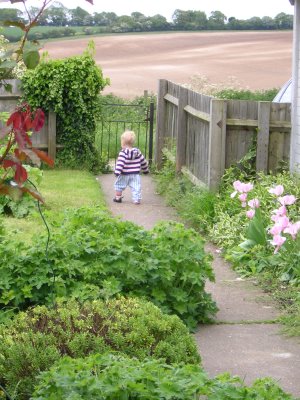Real Veal
 I have now learned several important things. The conventional veal business is very messy. A veal calf cannot be raised to commercial size without grain and hormones without getting too old to be veal. Now the folks at Knee Deep Cattle Co., who supply Prather Ranch Meat Co. (PRMC) with their vittelone, raise calves the right way. Vitellone is the term used in Italy for "red veal", loosely translated as "young beef", which is slightly older than traditional veal and not milk-fed . Their animals are treated humanely, fed grass and supplemental hay, and left in the pasture to be calves. As a result, this Real Veal is like beef, but lighter and more tender. It is not pale white or artifically mild like milk-fed factory veal. Of course, it is too old to be technically "veal", which is why they call it "vittellone" at PRMC. They slaughter their animals at 4-5 months, while the U.S.D.A. limit for veal is three months. I had a Vittelone T-Bone tonight that, quite frankly, was cut more like a Porterhouse. (I'll never say no to a little extra fillet). With a hearty pinch of salt, a few grinds of pepper, and a rub of olive oil, this lovely steak came off the grill just perfect. So if you happen to run into the head of the U.S.D.A., let him or her know that we need a new classification of marketable beef between veal and beef. My suggestion is that we use Cruel Veal, Real Veal, and Beef. I am not being maudlin here. Do a web search under the term 'veal' and see what you find.
I have now learned several important things. The conventional veal business is very messy. A veal calf cannot be raised to commercial size without grain and hormones without getting too old to be veal. Now the folks at Knee Deep Cattle Co., who supply Prather Ranch Meat Co. (PRMC) with their vittelone, raise calves the right way. Vitellone is the term used in Italy for "red veal", loosely translated as "young beef", which is slightly older than traditional veal and not milk-fed . Their animals are treated humanely, fed grass and supplemental hay, and left in the pasture to be calves. As a result, this Real Veal is like beef, but lighter and more tender. It is not pale white or artifically mild like milk-fed factory veal. Of course, it is too old to be technically "veal", which is why they call it "vittellone" at PRMC. They slaughter their animals at 4-5 months, while the U.S.D.A. limit for veal is three months. I had a Vittelone T-Bone tonight that, quite frankly, was cut more like a Porterhouse. (I'll never say no to a little extra fillet). With a hearty pinch of salt, a few grinds of pepper, and a rub of olive oil, this lovely steak came off the grill just perfect. So if you happen to run into the head of the U.S.D.A., let him or her know that we need a new classification of marketable beef between veal and beef. My suggestion is that we use Cruel Veal, Real Veal, and Beef. I am not being maudlin here. Do a web search under the term 'veal' and see what you find.




